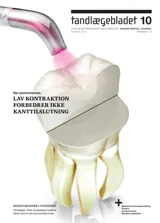Marginal adaption of a low-shrinkage silorane-based composite: A SEM-analysis
SEM-undersøgelse af et plastmateriale med lav kontraktion
Introduktion – Kontraktion i forbindelse med lyspolymerisering af plastfyldninger kan føre til spaltedannelse og dermed skade fyldningernes kanttilslutning. For at mindske problemerne med polymerisationskontraktion har man markedsført et nyt materiale (Filtek™ Silorane, 3M-ESPE, Tyskland) med en reduceret kontraktion. Formål – Studiets formål var at undersøge, om en reduceret polymerisationskontraktion forbedrer kanttilslutningen af plastfyldninger. Materiale og metode – I alt 156 scanning elektron mikroskopiske (SEM)-billeder (78 fra baseline, 78 fra followup) af okklusalfladen på molarer indgik i undersøgelsen. De undersøgte fyldninger blev lavet i forbindelse med en randomiseret klinisk undersøgelse, foretaget i 2007-2009, som sammenlignede de kliniske egenskaber for Filtek™ Silorane med Ceram∙XTMmono (Dentsply DeTrey, Tyskland). Ud fra epoxyaftryk af fyldningerne blev der fremstillet SEM-billeder af fyldningerne i 16 x forstørrelse. Billeder fra baseline og followup (398 dage, SD 29 dage) blev randomiseret således, at undersøgeren var blindet over for fyldningernes alder. Ligeledes var undersøgeren blindet over for type af fyldningsmateriale. Stereologi blev anvendt til at beregne længde og bredde af kantdefekterne. Resultater – Der var ikke statistisk signifikant forskel på spaltedannelse eller ”chipping” ved de to materialer. Konklusion – Studiets resultater understøtter ikke hypotesen om, at en reduceret polymerisationskontraktion forbedrer fyldningernes kanttilslutning.
Introduction – Shrinkage during polymerization of resin-based composite materials may lead to gap formation and hamper the marginal adaptation of the restorations. To reduce the problem of polymerization shrinkage, a new composite material (Filtek™ Silorane, 3M-ESPE, Germany), with a reduced shrinkage, has been marketed. Objective – To investigate whether reduced polymerization shrinkage improves the marginal adaptation of composite restorations. Material and methods – A total of 156 scanning electron microscopy (SEM) pictures (78 baseline, 78 follow-up) of the occlusal part of Class II restorations in molars were included in the study. The restorations originated from a randomised clinical trial, conducted in 2007- 2009 which compared the clinical performance of a low-shrinkage composite material (Filtek™ Silorane) with that of a methacrylate-based composite material (Ceram•X™mono). Eponcasts of the restorations were used for SEM pictures at x 16 magnification. Pictures from baseline and follow-up (398 days, SD 29 days) were randomised and the examiner was blinded to the material and the age of the restoration. Stereological measurements were used to calculate the length and the width of the marginal discrepancies. Results – No statistically significant difference in gap formation and chipping was found between the two materials. Conclusion – The results of the present study do not support the hypothesis that reduced polymerization shrinkage improves the marginal adaptation.


